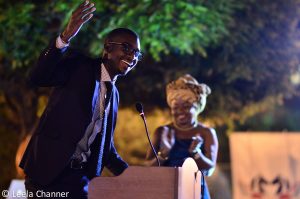Behind the Scenes at the Land Restoration Awards
By Alan Channer
‘‘Let’s have an awards ceremony at the Beating Famine conference in Bamako – and let’s have the ceremony at a gala dinner.’ Dr Dennis Garrity was in brainstorming mode. ‘‘Celebrating success in land restoration is one of the most effective ways of scaling-up,” he went on to tell me. ‘‘I’d like to set up an awards working group and I want you to produce a video on each awardee, to be screened on the night. Let’s make this happen.’’
Shortly afterwards, Tony Rinaudo, laureate of the prestigious Right Livelihood Award, offered to chair the awards committee. Dr Chris Reij from the Netherlands, Bob Winterbottom from the United States, Salima Mahmadou from Niger and Dennis completed a distinguished team of jurors.
A notice about the award was sent out and the applications came flooding in.
Early in January 2019, the awards committee met by Skype to review the selection of the awardees based on the jurors’ five criteria: impact, innovation, reach, creativity/charm and potential.
As Tony recalls, “Working through the submissions, it was very heartening to see how different actors at different levels – farmers, NGOs, researchers, communities – are embracing FMNR, and that many are actively reaching out to their neighbours and beyond to spread the practice. FMNR is a much more widely known, accepted and practised intervention than I had realised. It’s always thrilling to come across people who’ve ‘caught the bug’ and who come alive when they talk about it.”
However, the jury also observed that many promising submissions did not have sufficient supporting evidence. This is probably a salient observation for us all: make sure to get good documentation of your work! The jury also noted a couple of key lessons for the next awards process: ensure more lead time for applications and make more guidance available to applicants.
My role to produce the videos then started. I asked the nominators of the 10 awardees to send me the best photographic and video material they could get hold of.
I was taken aback by the quality of the documentation and the power of the 10 stories that were waiting to be told. I got excited. I wrote to colleague Vanessa Mulangal
a, ex BBC World Service reporter for Francophone Africa, and told her about this fantastic project to promote land restoration in Africa. “The budget is very low, the timeline is very tight – but will you do it?” She wrote back: “Yes, it sounds great.”
I asked Rocky Szostak, graphic designer and editor of promotional and music videos in the south of France, the same question. “Yes,” he said, and set to work designing a template for each award video.
Thus the 10 ‘Excellence in Land Restoration Award’ videos came to birth.
10 award certificates were designed and printed; 300 guests took their seats at the poolside venue of the Azalaï Hotel; strains of traditional Malian music filled the air; dinner was served and the delightful MC Albertine Dotsey from Togo took to the stage. The scene was set for the Gala Dinner and Ceremony of the inaugural ‘Excellence in Land Restoration Awards’.
One by one, the 10 awardees stepped up into the spotlight to claps and cheers from the guests. They received their awards from eminent personalities, including the Senegalese Ambassador to Mali and the Right Livelihood Laureate Yacouba Sawadogo, ‘the man who stopped the desert’. Each champion of land restoration spoke passionately about their work. Cecilia Tapok from Ghana spoke in Talensi; Sakina Mati from Niger spoke in Hausa; Salif Ali Guindo spoke in Bambara.
“I will treasure this moment.”
“I will take this award back to my community. We will spread FMNR more strongly than ever!”
Reflecting on the whole process, Tony Rinaudo commented: “I think that the outcome of the awards ceremony will be felt for years to come, particularly for the farmers and communities who do their work largely from public view. We’re definitely going to do this again.”
